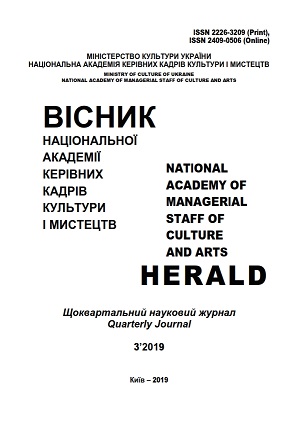Становлення європейського піанізму кінця XVIII – першої половини ХІХ ст
Formation of European Pianism of the End of the XVIII - the First Half of the XIX Century
Author(s): Maria Pavlivna Kalashnik, Anton Oleksandrovych GenkinSubject(s): Music, 18th Century, 19th Century, History of Art
Published by: Національна академія керівних кадрів культури і мистецтв
Keywords: pianism; European pianism; piano performance; virtuoso pianist; interpreter pianist;
Summary/Abstract: The purpose of the article is to systematize the information about the phenomenon of "pianism" available in the works on theory, history of culture and art and to investigate the dynamic system characteristics of European pianism of the late 18th - first half of the 19th century. The methodology is based on the concepts and theoretical conclusions in the field of art history and cultural studies. With the aim of disclosing the phenomenon of European pianism as a hierarchical and dynamic systemic fact, the research methodology consisted of the following methods: theoretical generalization, analysis, synthesis; historical and systematic approach. The scientific novelty of the research is determined by the fact that the information on the determinants of the ―pianism‖ phenomenon has been summarized of the scientific literature, the concept of pianism has been formed as a phenomenon of musical and performing culture, which is revealed as a hierarchical, dynamic, open system, and the main vectors of development of European pianism of the late XVIII - first half of the XIX century are also characterized in the article. Conclusions. Developing for about sixty years, ―pure‖ pianism held its ground, taking various forms during its formation and evolution. In the most general terms, stands out the intra-pianistic (immanent) form, which bears the semantic "radiation" of piano-performing art and the extra-pianistic (all-around and extra-musical) form. In the first of them, the installation for perfection and harmony reigns, which index the image of beauty and the clarity and equality of the game in motor skills (mainly manual) is adjacent to the ―illusiveness‖ of the sound, which is achieved with the help of textured-pedal means. In the future, there will be an enthusiasm for the octave technique while maintaining the main condition - cleanliness and clear articulation of the performing ―language‖. The second form of manifestation of the aesthetic ideal of pianism in the "era of virtuosos", while maintaining its "purity", is aimed at attracting pianistic means to a wider range of spiritual, meaningful and stylistic phenomena. Piano motility and cantilena (―singing‖) are interpreted as a symbolic expression of two main figurative and semantic spheres of the romantic worldview: games and lyricism, which act as different facets of personal self-expression. So ―piano‖, which lies at the basis of the aesthetic ideal of ―pure‖ pianism, turns out, on the one hand, the sound emblem of romanticism, and on the other hand, it is a conductor of general musical (specific) ideas of a certain historical time. The coexistence of multidirectional artistic tastes in a single historical plane makes it possible to interpret the ―virtuoso era‖ under the sign of ―polyphony‖ with the asynchronous updating of its various tendencies. The main figure of this era, if viewed from the inside, still remained a virtuoso pianist, who only in the second half of the XIX century gave way to an interpreter pianist. That is, other musicians slowly grew alongside the figures of virtuoso pianists, whose work was more connected with interpretational tasks and broader - comprehension of piano performance in terms of its cognitive abilities, capable of conveying as much as possible, even comprehensive content.
Journal: Вісник Національної академії керівних кадрів культури і мистецтв
- Issue Year: 2019
- Issue No: 3
- Page Range: 155-160
- Page Count: 6
- Language: Ukrainian

